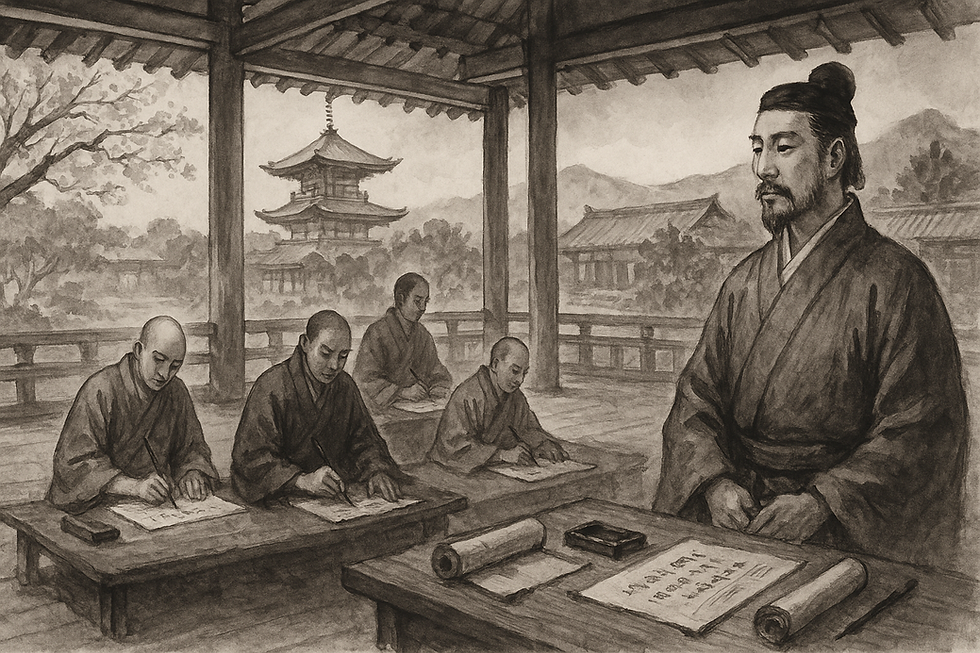Soga no Umako and Japanese Calligraphy — From Spiritual Culture to a Global Expression of Japanese Beauty
- 清水 芳樹
- 5月31日
- 読了時間: 3分

Japanese calligraphy is not only a tradition cherished by those living in Japan today — it is a cultural art form that captivates people around the world. At its roots lies the cultural and spiritual legacy shaped by Soga no Umako during the Asuka period. In this final column, we explore how “Japanese calligraphy,” born in Umako’s era, took root as a spiritual practice in Japanese society and eventually spread across the modern world.
Calligraphy as the “Way of the Heart” — The Spiritual Culture Fostered by Soga no Umako
During the Asuka period, Soga no Umako didn’t merely introduce Buddhism to Japan; he transformed the very meaning of “writing.” By spreading Buddhism, building temples, and supporting the practice of sutra copying, he helped elevate writing from a tool for communication to a spiritual discipline — a mirror of the soul, a path of personal cultivation.
Sutra copying was not simply about transcribing sacred texts. Every character was written with the intent to embody the Buddha’s teachings and express one’s prayer. In doing so, the mind of the scribe would be calmed, and their spirit refined. This notion — that “calligraphy reflects the heart” and “writing reveals the person” — became the philosophical bedrock of Japanese calligraphy.
These ideas have been passed down for over a thousand years, kept alive by generations of calligraphers and practitioners.
How Japanese Calligraphy Shaped Society
In Soga no Umako’s time, the spread of Buddhism also led to the rise of temples as centers of learning and culture. Monks, scholars, and artisans gathered at these temples, refining both their writing techniques and spiritual understanding through sutra copying and documentation. This temple-centered culture soon spread throughout Japan, embedding calligraphy deeply into daily life and society.
As the idea that “writing reflects the heart” gained ground, it began to influence not only artistic practices but also Japan’s spiritual worldview. Writing letters, documenting thoughts, and leaving records came to be seen as acts of self-expression and spiritual cultivation — and in turn, shaped human relationships and social values.
From Japan to the World — The Ongoing Legacy of Japanese Calligraphy
What began in Soga no Umako’s era evolved into a uniquely Japanese form of artistic expression that emphasized personal style and cultural refinement. From the Heian period onward, the creation of kana characters and the popularity of waka poetry gave rise to more flexible, emotionally rich expressions of the written word. Calligraphy became a part of daily life in Japan.
Today, Japanese calligraphy lives on through school education, New Year’s kakizome, exhibitions, and workshops held around the world. Its values — spirituality, serenity, mindfulness — transcend language and culture, resonating with people across the globe.
What draws so many to Japanese calligraphy is its depth: it’s not just about design or technique. At its core is a quiet prayer, a reflective moment, and a meditative encounter with the self.
The Enduring Legacy of Soga no Umako — Japanese Calligraphy Lives On
The temple culture established by Soga no Umako, the tradition of sutra copying, and the spiritual act of writing with intention — these continue to shape Japanese values and cultural identity even today. Japanese calligraphy, as a crystallization of these spiritual practices, has become a globally respected art and cultural form.
The courage to embrace the new, the importance of cultivating the spirit, and the joy of sharing culture with others — these lessons from Soga no Umako still speak powerfully to us today.
Japanese calligraphy will continue to transcend time and borders, connecting hearts and delivering quiet beauty to the world.
Experience authentic Japanese calligraphy:



Comments